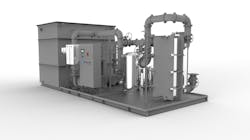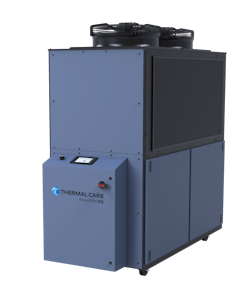3 ways variable speed control technology saves energy for process cooling
Variable speed control equipment is known by many different names. VFD (variable frequency drive), VSD (variable speed drive), AC Drive and Inverter are a few of the most common. Each of these controls an electric motor by varying frequency or voltage. For this article, we will focus on frequency as it is directly related to the speed of an electric motor. We will most often refer to them as VFDs, but the other acronyms or names are interchangeable.
There are multiple applications for VFDs in process cooling systems. Pumps, fans and compressors all utilize motors that can benefit from speed control. One of the most prominent benefits from a VFD is energy savings; however, there are other benefits as well. VFDs achieve improved output accuracy by adding a higher level of control over the equipment. And the longevity of the equipment is also extended by reducing wear on critical components.
How a VFD works
VFD systems operate based upon a feedback signal from the output of the motor its controlling, whether it is a fan, pump or compressor. The VFD accepts the feedback signal and adjusts the frequency supplied to the motor in response. This then affects the output of the motor. For example, a fan’s speed can be increased or decreased through a VFD’s feedback from a temperature sensor. When the temperature measurement is lower than the desired set point, the VFD will decrease the speed, generating less cooling and allowing the temperature to rise. This is known as a feedback loop and describes the basic operation of a VFD. Through this operation, the performance is continually monitored and adjusted by ramping the speed of the motor up or down as required. This allows the system to precisely match the demand and reduce any wasted effort or, in the case of an electric motor, energy consumption.
The benefits of VFDs for fans
Energy consumption is related to motor speed by a cubed relationship through the Affinity Laws, also commonly known as the pump laws. This aspect of a VFD’s effect is particularly interesting for fan applications. Consider a dry fluid cooler with eight fans. There are two methods of capacity control for this type of equipment — fan cycling and VFD control. If the demand on this fluid cooler is reduced by 50%, a fan cycling control design will shut off four of the fans. This reduces the energy consumption by 50%. A VFD control design will maintain all fans on but will reduce the speed of each simultaneously, ultimately saving 87.5% of the energy. This is a direct example of the Affinity Laws cubed relationship energy savings in action. Additionally, the effective surface area of the fluid cooler’s heat exchanger coil is optimized with VFD control. When fans are cycled off, air flow through the coils is no longer uniform and creates sub-optimal energy exchange. With VFD control, all fans are slowed but remain on. This maintains uniform airflow over the heat exchanger coils and uses the full surface area available to transfer the energy.
The benefits of VFDs for process pumps
A critical part of any cooling system is the process pump. This is the pump that circulates the process fluid — most commonly water — to the machinery that requires cooling. Process pumps benefit greatly with a VFD. The soft-start feature included with a VFD ramps the speed of the pump motor up slowly during startup. This prevents water hammer in the system and protects the piping infrastructure from damage. And it also extends the life of the motor by reducing bearing stress. The process pump’s VFD also accepts feedback from a pressure sensor. As processing machines are turned on and open valves for water flow, the pressure in the system piping changes. The VFD’s pressure sensor will detect this and relay the information to the VFD. This signals the VFD to respond to maintain the desired pressure setting by adjusting the speed of the pump. Using this design optimizes the pump supply to match the demand and conserve energy.
The benefits of VFDs for compressors
Compressors in chillers are the latest opportunity for VFD applications. Chillers are often the largest energy consumer in process cooling systems. The compressor is the heart of the chiller and drives the refrigeration circuit which creates the cooling. In the past, there were a few methods of capacity control for chillers. Each of these methods were used to address situations when the cooling demand was lower than the chiller’s design capacity. The first is compressor cycling. This simply would turn the compressor off when the temperature was below the set point by a predetermined amount. This solution creates unnecessary wear on the compressor with many starts and stops, and it reduces the chiller’s ability to accurately maintain the set point. The second method uses multiple compressors which are staged on or off to match the demand. Staging again introduces more wear on the compressors and is only viable for cooling systems with a large enough demand to merit multiple compressors. The third method is known as hot gas bypass control. When the cooling demand is lower than the chiller’s capacity, hot gas from the refrigerant circuit is bypassed directly into the evaporator. This, in essence, simulates the balance of the demand on the system keeping the compressor running all of the time. Using hot gas bypass eliminates the wear issues with cycling the compressor and addresses the temperature instability by forcing the compressor to remain on even in low-demand scenarios. The main drawback of this solution, however, is the excessive waste energy. If a 10-ton chiller only has a five-ton cooling demand, a hot gas bypass design will simulate the additional five tons. The chiller will consume the energy of a full 10-ton unit to cool only a five-ton load.
Using a VFD on a chiller’s compressor drastically reduces the energy consumption compared to a hot gas bypass solution. The compressor’s speed is modulated to only produce the amount of cooling required by the system. This eliminates the wasted energy associated with a hot gas bypass design and saves even more energy because of the Affinity Laws’ relationship between speed and power. A chiller with a VFD compressor also maintains extremely accurate temperature control. An additional benefit of a VFD chiller design is the flexibility for various applications. The same chiller can be moved throughout a facility to support a variety of applications, each with different cooling requirements.
In process cooling, all three of these applications will benefits from the ancillary effects of VFDs as well. Improved process control because of better set point accuracy makes production more effective. And the life of the motors is extended because of reduced wear from starting and stopping, protection from thermal overloads, phase imbalances and voltage variability. VFDs include a soft-start feature that reduces bearing wear, and for pumps, stops water hammer to protect the piping infrastructure from damage. A proper application of a VFD for process cooling equipment can have significant impact on a company’s operating costs, and payback periods to offset the cost of the VFD design are often less than 12 months.
Due to the wide range of options and various design, it is best to partner with qualified heat transfer system specialist to assist with designing a cooling system that is optimized for your level of desired cost and efficiency.
Tom Stone is National Sales Manager, Industrial Markets for Thermal Care. He has 14 years of experience in designing and applying process cooling solutions and has a degree in Mechanical Engineering from Purdue University. For more information visit Thermal Care at www.thermalcare.com or call 847-966-2260.
About the Author
Tom Stone
National Sales Manager, Industrial Markets for Thermal Care
Tom Stone is National Sales Manager, Industrial Markets for Thermal Care. He has 14 years of experience in designing and applying process cooling solutions and has a degree in Mechanical Engineering from Purdue University.


